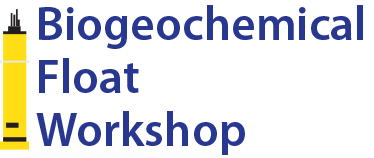Workshop Rationale
In recent years the development of a global, Biogeochemical Argo observing system based on profiling floats has begun. The Southern Ocean Carbon and Climate Observations and Modeling (SOCCOM) program is the best example of this to date, and other groups are engaged in the development and deployment of such floats elsewhere in the world ocean as an essential next step for ocean science and marine resource management (see the report of the Biogeochemical Argo Planning Group, 2016). The development of the ideas, technology, and strategy for such an observing system has been developed through a series of working groups (Gruber et al., 2007), international meetings (Claustre et al., 2010; Gruber et al., 2010; Johnson et al., 2009), and AGU Town Hall meetings. Many of these activities were sponsored by OCB. There are a number of international groups and individuals that plan to purchase and deploy such floats in the coming years, in conjunction with large, global programs or as part of smaller projects that examine more local aspects of the oceanic carbon cycle. Despite this growing interest, at the present time the expertise necessary to procure, test, and deploy this technology is confined to a few centers. This workshop, sponsored by OCB, is being held in order to begin the process of transferring this expertise to the larger ocean carbon community by bringing together potential users of this technology to discuss biogeochemical profiling float technology, sensors, and data management, in order to begin the process of the intelligent design of future scientific experiments.
References
Biogeochemical-Argo Planning Group (2016) The scientific rationale, design and Implementation Plan for a Biogeochemical-Argo float array. Edited by K. S. Johnson and H. Claustre. doi:10.13155/46601
Claustre, H., et al. (2010) Bio-optical profiling floats as new observational tools for biogeochemical and ecosystem studies, in Proceedings of the "OceanObs09: Sustained Ocean Observations and Information for Society" Conference, Venice, Italy, 21-25 September 2009, edited by J. Hall, Harrison D.E. and Stammer, D., ESA Publication WPP-306, doi:10.5270/OceanObs09.cwp.17.
Gruber, N., S. Doney, S. Emerson, D. Gilbert, T. Kobayashi, A. Kortzinger, G. Johnson, K. Johnson, S. Riser, and O. Ulloa (2007) The Argo-oxygen program: A white paper to promote the addition of oxygen sensors to the international Argo float program. Available at www-argo.ucsd.edu/white_paper_web.pdf.
Gruber, N., S. Doney, S. Emerson, D. Gilbert, T. Kobayashi, A. Kortzinger, G. C. Johnson, K. S. Johnson, S. C. Riser, and O. Ulloa (2010) Adding oxygen to Argo: Developing a global in-situ observatory for ocean deoxygenation and biogeochemistry, in Proceedings of the "OceanObs09: Sustained Ocean Observations and Information for Society" Conference, Venice, Italy, 21-25 September 2009, edited by J. Hall, D.E. Harrison, and D. Stammer, ESA Publication WPP-306, doi:10.5270/OceanObs09.cwp.39.
Johnson, K. S., W. M. Berelson, E. S. Boss, Z. Chase, H. Claustre, S. R. Emerson, N. Gruber, A. Kortzinger, M. J. Perry, S. C. Riser (2009) Observing biogeochemical cycles at global scales with profiling floats and gliders: prospects for a global array. Oceanography, 22(3), 216-225.
